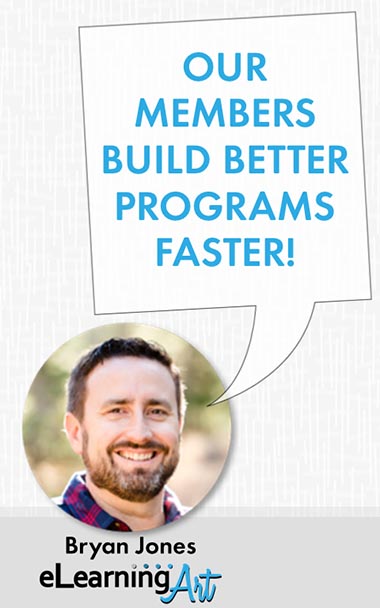Synopsis
Learn how to create a template with 3 different views of a chalkboard or other display board. The zoomed out view allows a character to act as a presenter with information on the board behind him. The zoomed-in view focused just on the board with the content.
Video Transcript
Hey this is Bryan Jones from eLearningArt. And today I just wanted to show you how I created one of the display board templates with the three different views. I had done a blog post about this earlier, and I just wanted to go through some of the details.
So let’s go ahead and take a look at one of these screens, and you’ll see that I have the selection and visibility pane open over here, and I can hide certainly elements. But basically I just wanted to show you that what the elements are the screen.
I have the person, I have the chalkboard, I have the wall, and the floor, and then this baseboard. So why don’t I go ahead and just get started from scratch. Since it’s the biggest component, let’s start with the wall. What I would do here is I would insert a shape, and what we have here is actually just a fill.
So if I got to format shape, and I got to picture or texture fill, and then I’m going to insert from file, and I have a number of different repeat textures here. I have another lesson on how to use repeat textures. But you’ll see here I have red brick. If I double-click that, and you’ll see the perspective is a little bit off here, I want to tile the picture.
And now I can control some of the scale here, so to get the brick the right size. So I can do however I want. Let’s just try 60 and 60% and see how that looks. That’s not bad, it might not be quite right. But then I could control where that is.
There is rectangle two there, I might want to rename that, but I kind of move that to – back there, and there we are. Now this, here, is also just another rectangle, the baseboard. So I would just draw a rectangle, and I’m not exactly sure what the features are on this one, but let me go ahead and recreate it.
I’m going to format the shape, and the same thing – you could do a color, and the – the more important thing is the 3D format, and I believe that I had some sort of bevel on it. So let’s put that bevel there, maybe it’s a little bit different than that. But let’s go to fill, and let’s go to picture or texture fill, and instead of the brick, this time I add concrete there.
And that looks pretty close. Get rid of that line color, so no line. And, you know, that’s not quite right, with the 3D format, I think maybe I had a six there, and maybe six here too, and let’s see if that does something for us.
And you could play around with those settings. But essentially that, you know, gives you a similar look to that. And the same thing, you can control the – the layering there as well. Now the floor doesn’t work quite as well with the texture repeat because you’ll see the perspective, the lines are kind of moving towards the vanishing point.
So I actually insert that as a picture that was created in – in Photoshop. So let me show you how that looks. I would just go to insert picture, and this one is just part of the baseboard, floor, wall. So I got to floor, you see I have a bunch of different things, and now there is the dark floor, and then you can drop that behind the wall, wherever you want. And let’s leave this old one. All right and then you can align it however you want.
And that’s how you get that look there. And you can kind of control it up and down if you want. Now before too much time passes here, this – this person is – is just a person image, and this is a pre-built asset as well, which is – which is just the chalkboard. But what you’re going to do then in these other perspectives, you’re going to do the same thing.
But you might want to bring the bricks bigger here, and same thing you’ll make the chalkboard bigger. And then on this last view, the same thing, you’re just inserting the chalkboard and scaling it up so that takes up the whole screen. And that way, you can really fill up the screen with your content.
And sometimes with the perspective, it’s helpful to either look over in this the – the slide view over here, or the other thing you can do, is you can put it in the sorter view, and that gives you some sense of what the perspective is. Anyways, I just wanted to show you how you can use these various assets to create the – the different display board views.
And I can build some other lessons on how some of the other ones are built to. But it’s just separate assets built together, scaled slightly different, and then – and that’s the basics of it. You can do that for a number of different display boards or screens. Hope you found that useful. Thanks so much for your time. Have a good day.


